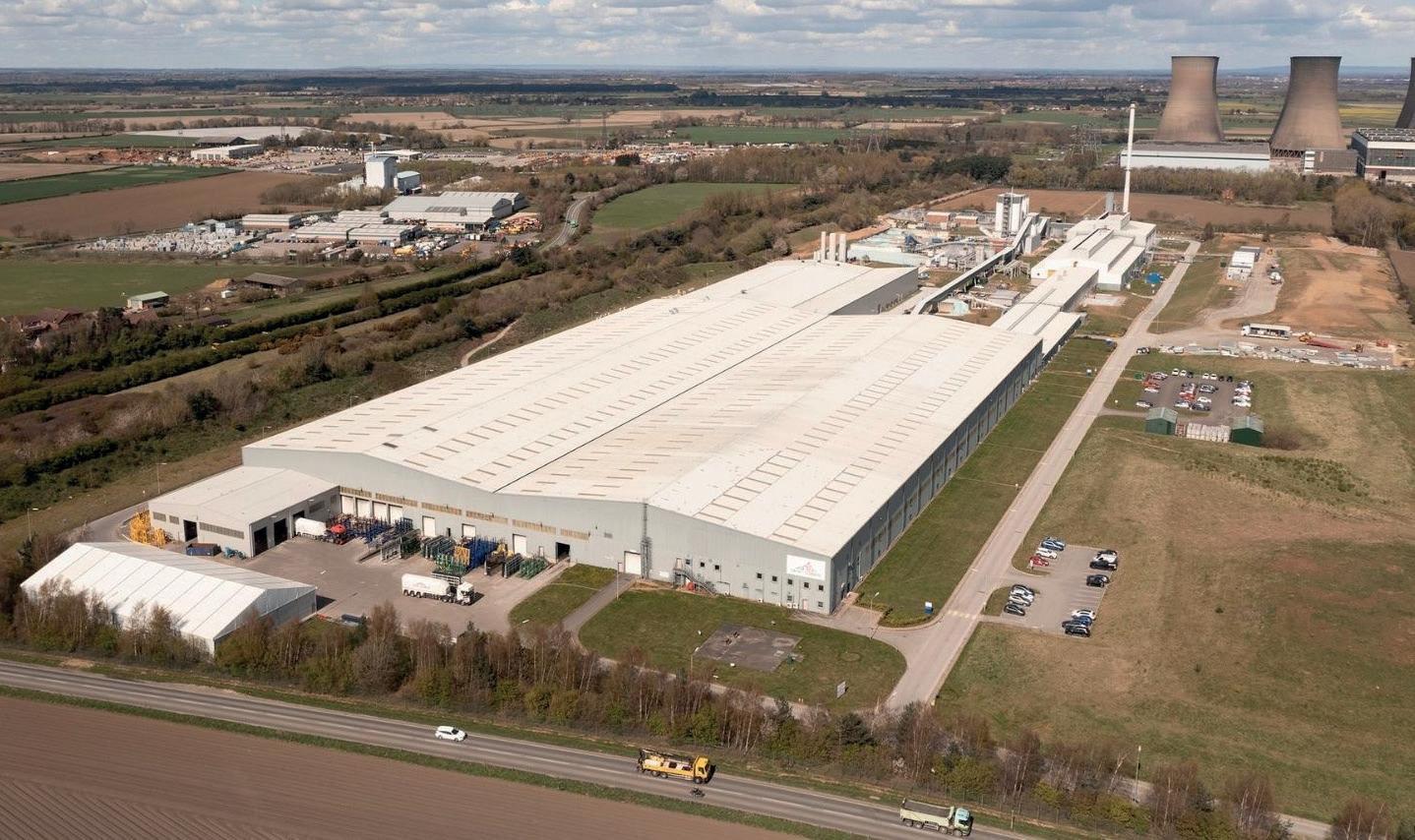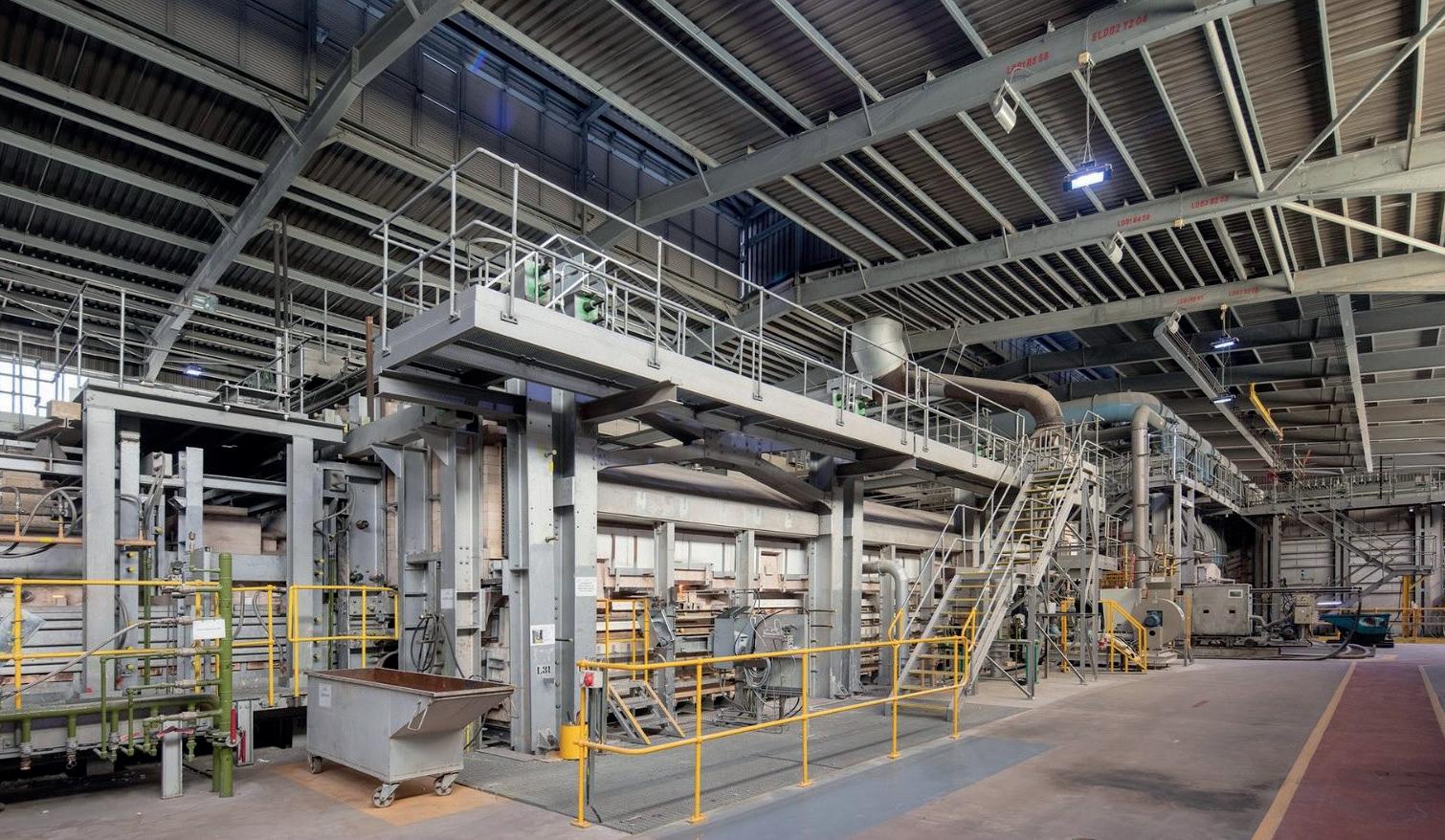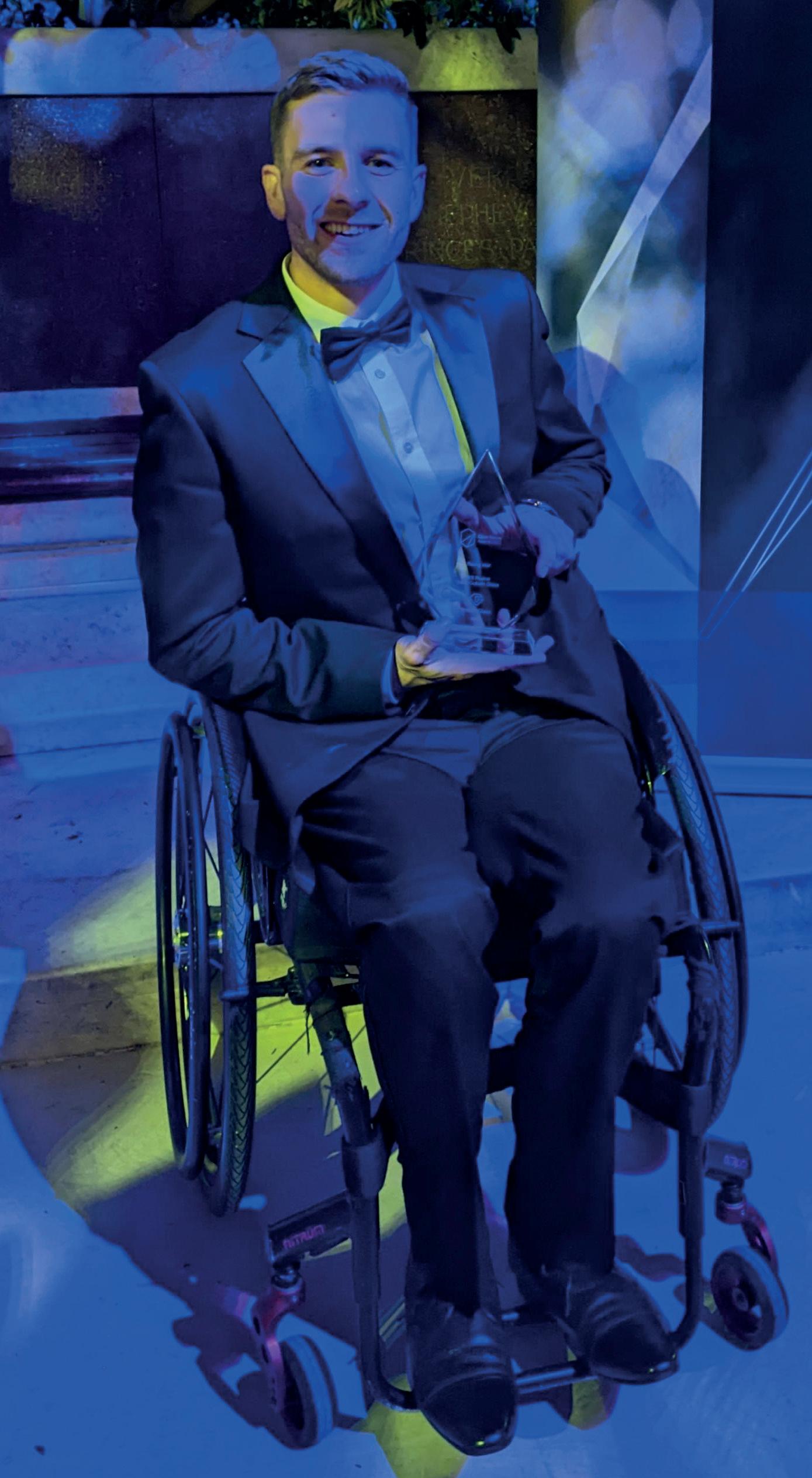
12 minute read
Personality profile: Will Ruane
[Above] Will on site at Saint-Gobain’s Eggborough plant in the UK.
Will overcomes adversity on his path as a rising star
Shortly after being named British Glass Rising Star of 2021, Saint-Gobain engineer Will Ruane* sustained a complete spinal cord injury while on holiday. The accident fractured his spine, leading Will to become paralysed from the waist down and a full-time wheelchair user. He discusses how his return to work and passion for the glass industry helped him on his rehabilitation journey.
In 2021, I was selected to be part of a global technical team as a Reporter for Saint-Gobain’s furnace repair at its Eggborough facility in North Yorkshire, UK (Pic 1).
The £30 million project was the largest industrial investment in the UK by Saint-Gobain since the Eggborough plant was built in 2000.
My contribution to the project, as well as my overall performance at Saint-Gobain, gained me British Glass’s Rising Star Award in November 2021, which was a really proud moment.
Once the ramp up of the manufacturing line was complete and production was stable, I took a holiday to Turkey in November, where I unfortunately sustained a complete spinal cord injury.
For me, a key part of rehabilitation was getting back to normality, which work was a massive part of. I find my job and what we do very rewarding.
My role has had to evolve slightly, but thanks to the support of Saint-Gobain, I have been able to return to work full-time.

Pic 1 – Saint-Gobain’s glass manufacturing factory in Eggborough, North Yorkshire, UK.
To be brutally honest, before I worked for Saint-Gobain, I had not heard of the company. So, I applied for the role of Finance Intern in 2015. But once I got there, I fell in love with glass manufacturing and realised that finance was not for me.
Once I graduated from my Accounting and Economics degree, I re-joined Saint-Gobain with the position of Management Trainee.
I then worked on the laminating line at Saint-Gobain’s Eggborough facility as a Production Assistant for nearly two years, before moving to the float line in 2019.
The thing that I still love to this day is the scale of the operation. The amount and the size of glass that we make. It really strikes me how challenging it is to make good glass.
We have a good understanding of the furnace, but due to the nature of it, it’s not something you can easily open up and see into. Glass is heavy industry, as I like to think of it. What particularly attracted me to it is the final product.
At the Eggborough plant, we make glazing products for the residential and commercial sector. We take raw materials and melt them in the furnace before the glass pours onto a bed of molten tin in the float bath, known as one continuous ribbon of glass.
We also have off line transformation capabilities at Eggborough, so the glass can be either sent to our customers as float glass or it can be coated or laminated depending on our customers’ needs.
The fact that glass is infinitely recyclable is just like no other material. We talk about single use plastic and what an issue that is. But with glass, you can pass it through the furnace as many times as you want, and still get a beautiful product at the end of it.
It brings benefits to everybody’s life. I try and imagine a world without glass, and the what the buildings would look like. On a personal perspective, what my recovery in hospital would look like if there were no windows. I know it would be a much slower recovery and a lot less enjoyable not having natural light.
I think glass is a wonderful material that doesn’t get the credit it deserves because it’s seen as a household object. It is so much more than that. It would be a very boring life without glass.
Eggborough furnace repair
2021 was an exceptional year for the Eggborough plant with the cold repair.
Contractors from all over the world were brought in to help deliver the project on time, in budget, all during the global pandemic.
The furnace was stopped for the first time since the line started in 2000, at which point it was knocked down and rebuilt completely using 7,000 tonnes of new refractory materials before heatingup and restarting production just 115 days later.
However, we were still able to supply our customers during that time, due to the stock built up leading up to the repair and the network within Saint-Gobain. (Pic 2)
As the Reporter for the heat up, I took measurements and ensured that the expansion was controlled while working with the teams that came from all over the world.
Once we restarted production, each day we would have multiple reviews of production and different parameters. I would also be involved in collating all the data to present our progress.
In the process of rebuilding the furnace, you’re heavily involved in parts of the line you’d never normally see. It was certainly a once in a lifetime experience. You’re standing inside a furnace, and that’s it for 20 years until it’s knocked down again. I was really pleased because I was the last person to leave the new furnace the night before we started the heat up.
We are at a higher tonnage capacity now than we have ever been. This is produced at a lower energy consumption, at a 20% energy reduction, due to the new design of furnace.

Pic 2 – Interior of the Eggborough site.
Saint-Gobain also continues to use a high percentage of cullet. We are at a minimum level of 40% cullet and aim to grow that further given the direct and positive impact on the environment, and the reduction of energy required in the process.
The fact that Saint-Gobain put me forward for the Rising Star award, and then British Glass recognised that it was an exceptional year and the role that I played in it, was a really proud moment (Pic 3). It was a nice recognition of what was a very challenging year.
I’d like to think that I’ll see another furnace repair at Eggborough in another 20 years. That’s my goal.
Accident
After the incredible experience of the cold repair and subsequent heat-up and restart of the line, I thought I needed a well-earned holiday.
So, I went away with my friends in early November, and that’s unfortunately where I had my accident in Turkey.
I fell down some stairs, which fractured a vertebrae in the low thoracic section of my spine at T11 level (just above my waist).
After 5 hours in surgery, I woke up with titanium rods and screws fixating five vertebrae in my spine from T9 to L1. However, unfortunately the fracture led to damage of my spinal cord at T11 level.
The spinal cord is effectively the motorway that the signals from your brain travel down. From that point forward, everything below the injury doesn’t work; fully paralysed, no feeling or movement. So, I’m a full-time wheelchair user now.
Bowel and bladder functions have been impacted because, again, that’s below the injury. As well as temperature regulation, blood pressure regulation - all these sorts of weird and wonderful things that happen with a spinal cord injury.
I spent two weeks in a hospital in Turkey recovering before I flew back to the UK. Long story short, I went to a number of different hospitals but eventually ended up in Sheffield at the Spinal Rehab Centre, and stayed there until the end of February 2022.
So, I left hospital after nearly four months. Then I returned to work in April, a couple of months after coming out of hospital.
Return to work
Saint-Gobain has been unbelievably supportive. They allowed me to come back on a phased return.
When I first came out of hospital, I was very physically tired. There was no way could I come back on five days a week.
Everything takes longer and is harder. This is not moaning, it’s just fact. It might have taken me 20 minutes to get ready before my injury, now it might take me 45 minutes on a morning. Even putting a pair of socks on now still is difficult, you have to wrestle with your foot to get it to your face.
So I went from a day a week, then two days a week, and so on. I’ve built up back to full time now.
My role evolved from Production Assistant, because that’s quite hands on, particularly in the hot end around the furnace. It would involve going out, taking pyrometer readings at the furnace, doing work in the batch plant, doing measures, at times working with the masonry team, and working with the hot and cold end operators.
Clearly, there are many parts of the glass factory which are not accessible in a wheelchair and unfortunately, probably never will be by nature of the industry. So, my role had to evolve. But it’s not drastically different, just a slight tweak.
My work as a Research and Development Engineer is data-driven. It’s aimed at improving quality, improving yield, reducing energy consumption, and working with plants all across the global Saint-Gobain network. For example, I work closely with our technical department in Paris.
In September 2022, I spent a week in Paris working with them. I thought after my accident that part of my career had ended. I didn’t think I’d be able to do international travel. But I’ve been very surprised about what I’ve been able to do thanks to Saint-Gobain’s support.
Even in my wheelchair, I can still get around the line; I can get around the burner corridors, as we call them, next to the furnace.
Saint-Gobain also bought me a wheelchair that stands up. So, I just push it up and it will literally stand me up and support my legs (see video link 1 below). This meant that for the first time in 12 and a half months, I got to look into our furnace with my own eyes. So that was just incredible.
A few people have said to me after a life changing injury like this to ‘take a year or two off to come to terms with it’ and have time for your rehabilitation.
But, for me, getting back to work was a key part of my rehabilitation because I wanted to gain my independence back.
I describe it to people that, when you have an accident, you almost become a baby in an adult’s body. You can’t do anything for yourself for a period of time. So, it’s about getting small wins, getting the independence back.
For me, a key part of rehabilitation was getting back to normality. Me coming out of hospital and then not working, that’s not normal.
I work for Saint-Gobain and for the glass industry because I want to get reward in return. I find my job and what we do very rewarding. The people that I work with at the Eggborough site are fantastic as well as in the wider glass community, within Saint-Gobain and externally.
I don’t know if you ever complete rehab. It’s only been 10 months since I left hospital, but it’s not a recovery as such because you’re never going to get better – it’s a lifelong condition now.
So, I don’t think you can ever say you finish your rehabilitation journey or are recovered, but it’s that continual improvement. It’s never been satisfied with what you’ve got, always wanting to get better. Work is a massive part of that for me.
The future
I’m a big believer, and am really keen to show people, that working in the glass manufacturing industry with a disability is not only fantastic, but possible.
I’m still working towards becoming a Float Line Senior Manager. I would say that when I was lying in hospital, I had doubts that it would be possible.
But the more you think about it, what actually is the role of the manager? To lead a department and navigate across challenges. So, why not? Just because I’m in a wheelchair, doesn’t mean that I don’t have the technical knowledge. Everything that I did before, I’m just doing sat down now.
I think the way that technology is moving has opened a lot of doors. For example, technology allows me to see into the furnace. I can look into the float bath, I can be close to the line, and I can take quality samples and look at them.
Managing a float line is clearly more than just managing a process. A big element of it is managing people. I’ve not changed after my accident, so there’s no reason think I can’t continue on the path of float line management.
I also think increasing diversity in the workplace is extremely important. It only brings benefits. If the right people are in the right position because of the talents and merits they bring, not because they tick a box by any means, then increasing diversity and inclusivity in the workplace is fantastic.
People from different backgrounds, with disabilities or not, will bring different ways of thinking, different approaches. And life would be pretty boring if we were all the same, I think it’s fair to say.

Pic 3 – Will at the 2022 British Glass Awards in Liverpool, UK.
*Research and Development Engineer, Saint-Gobain, Eggborough, UK | https://www.saint-gobain.com/en
Will has also been documenting his rehabilitation journey on Instagram, which includes training for a half marathon this April to raise money for The Matt Hampson Foundation where he receives his physiotherapy. See Link 2 to follow his journey.
Links:
1. https://www.instagram.com/reel/ ClR8hXGIh2l/?igshid=YmMyMTA2M2Y=
2. https://www.instagram.com/willruane/?hl=en










